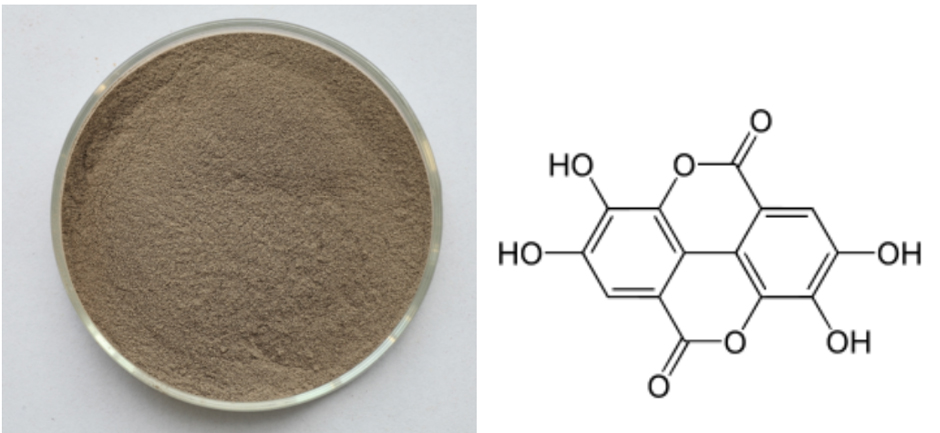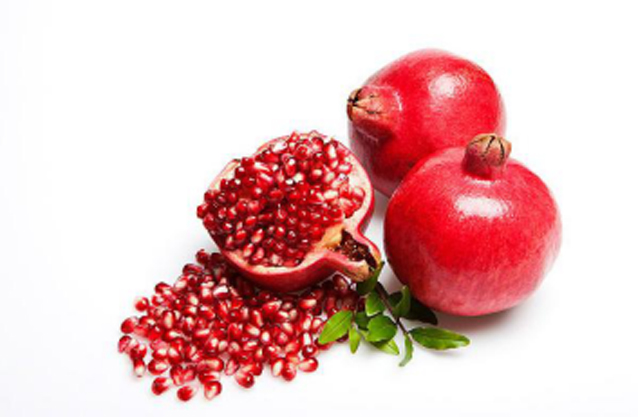Hot sale good quality Pomegranate seed extract Supply to Serbia
Hot sale good quality Pomegranate seed extract Supply to Serbia Detail:
[Latin Name] Punica granatum L
[Plant Source] from China
[Specifications]Ellagic acid≥40%
[Appearance] Brown Fine Powder
Plant Part Used:Seed
[Particle size] 80 Mesh
[Loss on drying] ≤5.0%
[Heavy Metal] ≤10PPM
[Storage] Store in cool & dry area, keep away from the direct light and heat.
[Shelf life] 24 Months
[Package] Packed in paper-drums and two plastic-bags inside.
[Net weight] 25kgs/drum
Introduction
Pomegranate, (Punica granatum L in Latin), belongs to the family Punicaceae which includes only one genus and two species. The tree is native from Iran to the Himalayas in northern India and has been cultivated since ancient times throughout the Mediterranean region of Asia, Africa and Europe.
Pomegranate offers abundant benefits for the cardiovascular system by preventing damage to arterial walls, promoting healthy blood pressure levels, improving blood flow to the heart, and preventing or reversing atherosclerosis.
Pomegranate may benefit people with diabetes and those at risk for the disease. It helps lower after-meal blood sugar levels and protects the cardiovascular system from diabetes-induced damage.
Pomegranate shows promise in killing prostate cancer cells, whether the cells are hormone-sensitive or not. Pomegranate also helped halt the progression of prostate cancer in men who had undergone surgery or radiation for the disease.
Pomegranate may fight the degeneration of joint tissue that leads to painful osteoarthritis, and may protect the brain against oxidative stress-induced changes that can lead to Alzheimer’s. Pomegranate extracts—alone or in combination with the herb gotu kola—help kill the bacteria that contribute to dental plaque, while helping to heal gum disease. Pomegranate also appears to protect the health of the skin and liver.
Function
1.Anti-cancer of rectum and colon, esophageal carcinoma,liver cancer,lung cancer,carcinoma of tongue and skin.
2.Restrain to human immunodeficiency virus(HIV) and many kinds of microbe and virus.
3.Anti-oxidant, coagulant, descenting blood pressure and sedation.
4.Resist to anti-oxidance, senescence inhibition and skin whitening
5.Treat kinds of symptoms caused by high blood sugar, hypertension.
6.Resist to atherosclerosis and tumour.
Application
Pomegranate P.E. can be made into capsules, troche and granule as healthy food. Besides, it has good solubility in water plus the solution transparence and brilliance color, has been widely added into the beverage as the functional content.
Product detail pictures:

Related Product Guide:
We insist on offering premium quality creation with very good company concept, honest product sales along with the finest and fast assistance. it will bring you not only the premium quality item and huge profit, but the most significant is to occupy the endless market for Hot sale good quality Pomegranate seed extract Supply to Serbia , The product will supply to all over the world, such as: San Diego, Muscat, Casablanca, As an experienced factory we also accept customized order and make it same as your picture or sample specifying specification and customer design packing. The main goal of the company is to live a satisfactory memory to all the customers, and establish a long term win-win business relationship. For more information, please contact us. And It is our great pleasure if you like to have a personally meeting in our office.
https://www.ibiology.org/ibioseminars/jared-leadbetter-part-1.html
Talk Overview:
Leadbetter begins his seminar by comparing the biological diversity in the gut of the termite to the diversity found in the Sargasso Sea. The hindgut of the dampwood termite Zootermopsis nevadensis has one of the highest densities of microbes found on earth and includes bacteria, archaea and eukaryotes of all shapes and sizes. Protozoa in the termite gut breakdown the polysaccharides in wood to produce acetate; a food source for the termite. The breakdown of wood also produces H2 and CO2. Archaea in the gut convert the H2 and CO2 to methane, while bacteria compete to convert the H2 and CO2 to more acetate thus reducing methane production. Leadbetter and his colleagues were the first to identify and successfully culture acetogenic spirochetes from the termite gut. They have since found gut bacteria capable of fixing atmospheric nitrogen and producing protein. Using genetics, Leadbetter is now studying the diversity and evolution of termites and their gut bacteria.
Speaker Biography:
Jared Leadbetter was an undergraduate biology student at Goucher College when he attended a summer course on microbial diversity at the Marine Biological Laboratory in Woods Hole, Massachusetts. It was here that he first became fascinated with the amazing environment of the termite gut. Leadbetter went on to study termite gut microbes for his PhD at Michigan State University and as a post-doc at the University of Iowa.
Currently, Leadbetter is a professor of Environmental Microbiology and Environmental Science and Engineering at the California Institute of Technology. He is also co-director, with Dianne Newman, of the Marine Biological Lab’s summer course on Microbial Diversity. Using physiological, chemical and molecular genetics techniques, Leadbetter’s lab strives to understand the symbiotic relationship between termites and their diverse gut microbes. A better understanding of how termite gut microbes limit methane production and how they break down material such as lignin and cellulose may help reduce methane production by cows and improve the production of biofuels.
What is GLYCOGEN? What does GLYCOGEN mean? GLYCOGEN meaning, definition & explanation.
Source: Wikipedia.org article, adapted under https://creativecommons.org/licenses/by-sa/3.0/ license.
Glycogen is a multibranched polysaccharide of glucose that serves as a form of energy storage in animals and fungi. The polysaccharide structure represents the main storage form of glucose in the body.
In humans, glycogen is made and stored primarily in the cells of the liver and the muscles hydrated with three or four parts of water. Glycogen functions as the secondary long-term energy storage, with the primary energy stores being fats held in adipose tissue. Muscle glycogen is converted into glucose by muscle cells, and liver glycogen converts to glucose for use throughout the body including the central nervous system.
Glycogen is the analogue of starch, a glucose polymer that functions as energy storage in plants. It has a structure similar to amylopectin (a component of starch), but is more extensively branched and compact than starch. Both are white powders in their dry state. Glycogen is found in the form of granules in the cytosol/cytoplasm in many cell types, and plays an important role in the glucose cycle. Glycogen forms an energy reserve that can be quickly mobilized to meet a sudden need for glucose, but one that is less compact than the energy reserves of triglycerides (lipids).
In the liver, glycogen can comprise from 5 to 6% of its fresh weight (100–120 g in an adult). Only the glycogen stored in the liver can be made accessible to other organs. In the muscles, glycogen is found in a low concentration (1-2% of the muscle mass). The amount of glycogen stored in the body—especially within the muscles, liver, and red blood cells—mostly depends on physical training, basal metabolic rate, and eating habits. Small amounts of glycogen are found in the kidneys, and even smaller amounts in certain glial cells in the brain and white blood cells. The uterus also stores glycogen during pregnancy to nourish the embryo.
It is a very good, very rare business partners, looking forward to the next more perfect cooperation!






